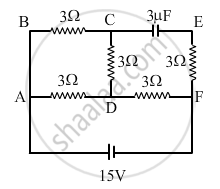Advertisements
Advertisements
प्रश्न
A low voltage supply from which one needs high currents must have very low internal resistance. Why?
उत्तर
According to Ohm’s law, the relation for the potential is V = IR
Voltage (V) is directly proportional to the current (I).
R is the internal resistance of the source.
I = `"V"/"R"`
If V is low, then R must be very low, so that a high current can be drawn from the source.
APPEARS IN
संबंधित प्रश्न
If the potential difference across the ends of a conductor is 220 V and the resistance of the conductor is 44 Ω (ohm), then the current flowing through is _________.
- 0.2 A
- 0.5 A
- 2 A
- 5 A
Let the resistance of an electrical component remains constant while the potential difference across the two ends of the component decreases to half of its former value. What change will occur in the current through it?
Name the unit of electrical resistance and give its symbol.
Name the law which is illustrated by the above V−I graph.
Ohm's law gives a relationship between:
(a) current and resistance
(b) resistance and potential difference
(c) potential difference and electric charge
(d) current and potential difference
How should the two resistances of 2 ohms each be connected so as to produce an equivalent resistance of 1 ohm?
Four resistances of 16 ohms each are connected in parallel. Four such combinations are connected in series. What is the total resistance?
In the circuit shown in the figure, find the total resistance of the circuit and the current in the arm AD.

How does an increase in the temperature affect the specific resistance of a :
(i) Metal and
(ii) Semiconductor ?
Tick(✓) the correct choice in the following:
Ohm's law is applicable to
State the limitations of Ohm’s law.
Define Current density.
Obtain the macroscopic form of Ohm’s law from its microscopic form and discuss its limitation.
Assertion: The statement of Ohm’s law is K = IR.
Reason: V = IR is the equation which defines resistance.
State Ohm’s law? How can it be verified experimentally? Does it hold good under all conditions? Comment.
A metal rod of length 10 cm and a rectangular cross-section of 1 cm × `1/2` cm is connected to a battery across opposite faces. The resistance will be ______.

Vinita and Ahmed demonstrated a circuit that operates the two headlights and the two sidelights of a car, in their school exhibition. Based on their demonstrated circuit, answer the following questions.
- State what happens when switch A is connected to:
a) Position 2
b) Position 3 - Find the potential difference across each lamp when lit.
- Calculate the current.
a) in each 12 Ω lamp when lit.
b) In each 4 Ω lamp when lit.
OR - Show, with calculations, which type of lamp, 4.0 Ω or 12 Ω, has the higher power.
The voltage - current readings of a certain material are shown in the table given below:
| Voltage (V) | 10 V | 20 V | 30 V |
| Current (I) | 2 A | 3 A | 4 A |
Study the table.
- State whether the conductor used is ohmic or non-ohmic.
- Justify your answer.
- State Ohm's law.
